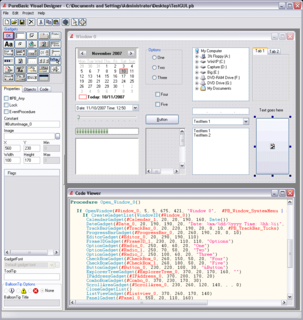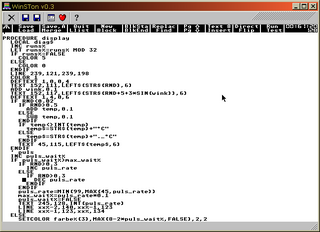Features
Version 6.5 includes 3D, Media, and Network Engines.
Included with the SDK are multiple tools to help speed up development: a shader editor, model viewer, exporting plugins for various modeling software (3D Studio Max, Maya, and Milkshape 3D currently) and particle effects editors. Because version TV3D 6.5 no longer supports outdated mesh formats, many converters are also available. An official world or map editor is not currently planned because it hinders the end-user, since there is no way one editor can be used for every project this engine is used for. Furthermore, TV3D is a 3D engine, not a game engine, and an official editor would limit it too much. However, there are some user-created map editors available.
Truevision3D is free to use as long as the user doesn't mind a logo in the corner of the rendering viewport. To remove the logo and publish a commercial project, a license needs to be acquired. Currently, the cost is $150 for a single-title license, $500 for a multi-title license. A source license can be purchased for an as yet undisclosed price.
VBScript is an Active Scripting language developed by Microsoft that is modeled on Visual Basic. It allows Microsoft Windows system administrators to generate powerful tools for managing computers with error handling, subroutines, and other advanced programming constructs. It can give the user complete control over many aspects of their computing environment.

Wine is a free and open-source compatibility layer that aims to allow application software and computer games developed for Microsoft Windows to run on Unix-like operating systems. Wine also provides a software library, named Winelib, against which developers can compile Windows applications to help port them to Unix-like systems.
Visual DialogScript (VDS) is an interpreted programming language for Microsoft Windows. It can be used to create small and fast programs. VDS has a large number of dialog and graphical elements available to create professional looking programs. VDS programs have access to the Windows API; therefore, it is possible to write applications that can perform the same advanced tasks as other programming languages such as Visual Basic, C++, or Delphi.

PureBasic is a commercially distributed procedural computer programming language and integrated development environment based on BASIC and developed by Fantaisie Software for Windows, Linux, and macOS. An Amiga version is available, although it has been discontinued and some parts of it are released as open-source. The first public release of PureBasic for Windows was on 17 December 2000. It has been continually updated ever since.
The Windows API, informally WinAPI, is Microsoft's core set of application programming interfaces (APIs) available in the Microsoft Windows operating systems. The name Windows API collectively refers to several different platform implementations that are often referred to by their own names ; see the versions section. Almost all Windows programs interact with the Windows API. On the Windows NT line of operating systems, a small number use the Native API.
Irrlicht is an open-source game engine written in C++. It is cross-platform, officially running on Windows, macOS, Linux and Windows CE and due to its open nature ports to other systems are available, including FreeBSD, Xbox, PlayStation Portable, Symbian, iPhone, AmigaOS 4, Sailfish OS via a QT/Qml wrapper, and Google Native Client.

GFA BASIC is a dialect of the BASIC programming language, by Frank Ostrowski. The name is derived from the company, which distributed the software. In the mid-1980s to the 1990s it enjoyed popularity as an advanced BASIC dialect, but has been mostly superseded by several other programming languages. Official support ended in the early 2000s.

Microsoft Visual Studio Express is a set of integrated development environments (IDEs) that Microsoft developed and released free of charge. They are function-limited version of the non-free Visual Studio and require mandatory registration. Express editions started with Visual Studio 2005.
Windows Presentation Foundation (WPF) is a free and open-source graphical subsystem originally developed by Microsoft for rendering user interfaces in Windows-based applications. WPF, previously known as "Avalon", was initially released as part of .NET Framework 3.0 in 2006. WPF uses DirectX and attempts to provide a consistent programming model for building applications. It separates the user interface from business logic, and resembles similar XML-oriented object models, such as those implemented in XUL and SVG.
The Access Database Engine is a database engine on which several Microsoft products have been built. The first version of Jet was developed in 1992, consisting of three modules which could be used to manipulate a database.

Windows Vista is a major release of the Windows NT operating system developed by Microsoft. It was the direct successor to Windows XP, which was released five years before, at the time being the longest time span between successive releases of Microsoft Windows desktop operating systems. Development was completed on November 8, 2006, and over the following three months, it was released in stages to computer hardware and software manufacturers, business customers and retail channels. On January 30, 2007, it was released internationally and was made available for purchase and download from the Windows Marketplace; it is the first release of Windows to be made available through a digital distribution platform.
Desktop Window Manager is the compositing window manager in Microsoft Windows since Windows Vista that enables the use of hardware acceleration to render the graphical user interface of Windows.
The Speech Application Programming Interface or SAPI is an API developed by Microsoft to allow the use of speech recognition and speech synthesis within Windows applications. To date, a number of versions of the API have been released, which have shipped either as part of a Speech SDK or as part of the Windows OS itself. Applications that use SAPI include Microsoft Office, Microsoft Agent and Microsoft Speech Server.
Windows Display Driver Model (WDDM) is the graphic driver architecture for video card drivers running Microsoft Windows versions beginning with Windows Vista.
The Microsoft Windows operating system supports a form of shared libraries known as "dynamic-link libraries", which are code libraries that can be used by multiple processes while only one copy is loaded into memory. This article provides an overview of the core libraries that are included with every modern Windows installation, on top of which most Windows applications are built.

The original Visual Basic is a third-generation event-driven programming language from Microsoft known for its Component Object Model (COM) programming model first released in 1991 and declared legacy during 2008. Microsoft intended Visual Basic to be relatively easy to learn and use. Visual Basic was derived from BASIC and enables the rapid application development (RAD) of graphical user interface (GUI) applications, access to databases using Data Access Objects, Remote Data Objects, or ActiveX Data Objects, and creation of ActiveX controls and objects.
ShiVa3D is a 3D game engine with a graphical editor designed to create applications and video games for desktop PCs, the web, game consoles and mobile devices. Games made with ShiVa can be exported to over 20 target platforms, with new export targets being added regularly.
XBLite is a free Open Source BASIC programming language compiler and development system. It was started in 2001 by David Szafranski in order to provide a Windows exclusive version of the XBasic dialect. XBLite is released under the GNU GPL licensing scheme, Standard libraries are released under the GNU LGPL licensing scheme.

Mono is a free and open-source .NET Framework-compatible software framework. Originally by Ximian, it was later acquired by Novell, and is now being led by Xamarin, a subsidiary of Microsoft and the .NET Foundation. Mono can be run on many software systems.

Godot (/ˈɡɒdoʊ/) is a cross-platform, free and open-source game engine released under the MIT license. It was initially developed by Argentine software developers Juan Linietsky and Ariel Manzur for several companies in Latin America prior to its public release. The development environment runs on multiple operating systems including Linux, BSDs, macOS, and Microsoft Windows. It is designed to create both 2D and 3D games targeting PC, mobile, and web platforms. It can also been used to create non game software, including editors.








